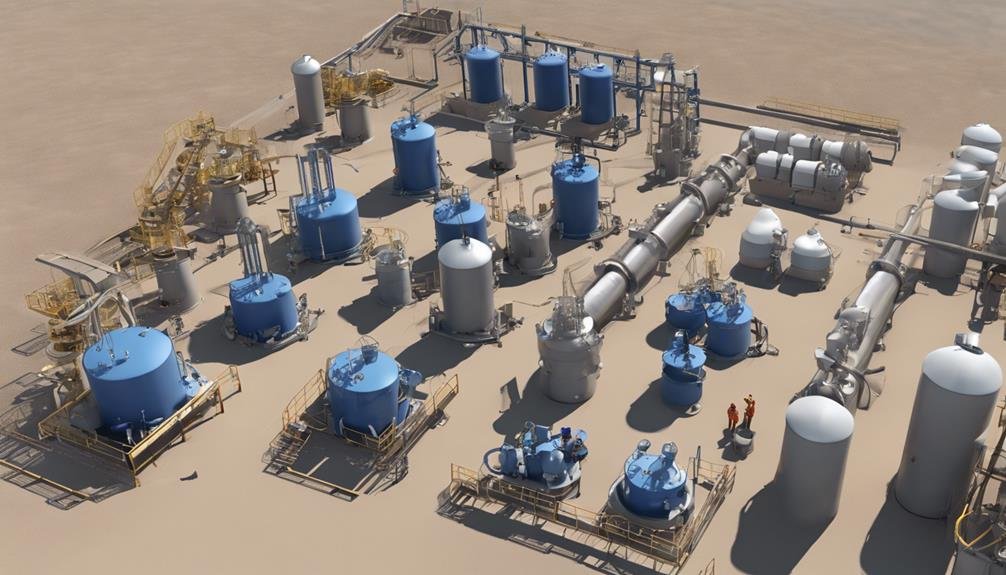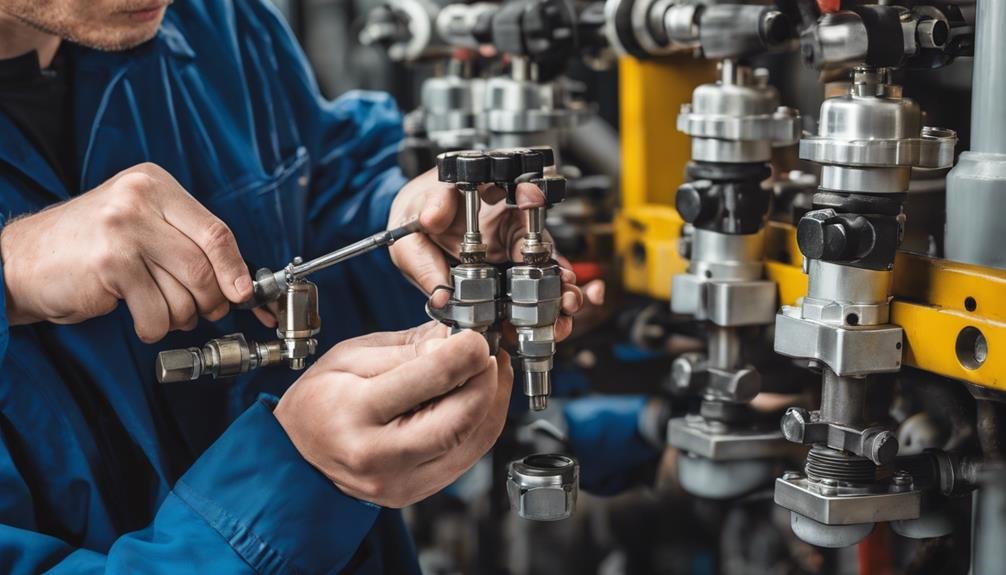To effectively control oil production, you need to implement key strategies that optimize operations and ensure compliance with industry standards. By focusing on equipment monitoring, production efficiency, and preventive maintenance, you can enhance overall performance and reduce downtime. But there's more to it than just these aspects. Stay tuned to discover additional crucial elements that play a significant role in managing oil production effectively.
Key Takeaways
- Implement advanced sensors for real-time monitoring.
- Utilize artificial lift systems for optimization.
- Analyze reservoir data for efficient management.
- Monitor key performance indicators for swift responses.
- Collaborate between production and reservoir teams for effective strategies.
Equipment Monitoring
When it comes to controlling oil production, ensuring effective equipment monitoring is paramount. Monitoring equipment is crucial for maintaining operational efficiency and preventing costly downtime. By implementing advanced sensors and monitoring systems, you can track the performance of critical equipment in real-time. This allows you to detect any anomalies or potential issues before they escalate, minimizing the risk of unexpected breakdowns.
Regular equipment inspections and maintenance checks are essential to ensure optimal performance. By conducting routine inspections, you can identify wear and tear, corrosion, or other issues that could impact production.
Additionally, monitoring equipment data and performance trends can help you make informed decisions regarding maintenance schedules and equipment upgrades.
Utilizing predictive maintenance techniques can further enhance equipment monitoring capabilities. By analyzing historical data and performance trends, you can predict when maintenance is required, optimizing maintenance schedules and reducing downtime.
Implementing a comprehensive equipment monitoring strategy is key to maximizing production efficiency and minimizing operational disruptions.
Production Optimization
To optimize production in the oil industry, it's imperative to streamline operational processes and enhance efficiency through strategic planning and implementation. By focusing on production optimization, you can achieve higher output levels while maximizing resources. Implementing advanced technologies like artificial lift systems and real-time monitoring tools can help identify potential bottlenecks and optimize well performance.
Efficient reservoir management techniques, such as water flooding and enhanced oil recovery methods, can also significantly improve production rates. It's crucial to continuously analyze production data and adjust strategies accordingly to ensure optimal performance.
Additionally, conducting regular maintenance checks on equipment and infrastructure is essential to prevent downtime and maintain operational efficiency.
Collaboration between production teams and reservoir engineers is key to developing effective production optimization strategies. By leveraging data analytics and predictive modeling, you can make informed decisions to enhance overall production performance. Remember, continuous improvement is the cornerstone of successful production optimization in the oil industry.
Workflow Analysis
With the increasing complexity of operations in the oil industry, conducting a thorough workflow analysis is crucial for identifying inefficiencies and streamlining processes. By analyzing the sequence of tasks and activities involved in oil production, you can optimize the efficiency of your operations. Here are three key steps to consider in conducting a workflow analysis:
- Identify Processes: Begin by mapping out each step involved in oil production, from exploration to refining. This will help you visualize the flow of work and identify potential bottlenecks or areas for improvement.
- Gather Data: Collect data on the time, resources, and costs associated with each process. This will provide you with valuable insights into where efficiencies can be gained and costs reduced.
- Collaborate with Stakeholders: Involve key stakeholders, such as engineers, geologists, and operations managers, in the workflow analysis process. Their expertise can offer valuable perspectives and help in developing effective solutions to enhance workflow efficiency.
Data Analytics
Following the workflow analysis to optimize oil production processes, the integration of data analytics emerges as a pivotal tool for enhancing operational efficiency and decision-making in the industry. By harnessing the power of data analytics, you can delve into vast datasets to uncover valuable insights that drive informed decision-making. Through advanced algorithms and machine learning techniques, you can predict equipment failures, optimize production schedules, and identify trends that lead to cost savings.
With data analytics, you can monitor key performance indicators in real-time, allowing you to swiftly respond to any deviations from the norm. By analyzing historical data, you can identify patterns that indicate potential issues before they escalate, enabling proactive interventions to prevent costly downtime.
Utilizing data analytics tools empowers you to make data-driven decisions that optimize production processes, reduce operational risks, and enhance overall efficiency. Embracing this technology won't only streamline operations but also position your company at the forefront of the industry's digital transformation.
Preventive Maintenance
Implementing preventive maintenance strategies is crucial in ensuring the reliability and longevity of oil production equipment. By proactively addressing potential issues before they escalate, you can minimize downtime and maximize productivity.
Here are three key points to consider when implementing preventive maintenance:
- Regular Inspections: Conduct routine inspections of equipment to detect early signs of wear and tear. This can help you identify and address potential problems before they lead to costly breakdowns.
- Scheduled Maintenance: Create a maintenance schedule based on manufacturer recommendations and equipment usage. Regularly servicing components such as pumps, valves, and pipelines can extend their lifespan and prevent unexpected failures.
- Use of Technology: Utilize advanced monitoring tools and software to track equipment performance and detect anomalies. Implementing predictive maintenance techniques can help you anticipate issues and take corrective actions proactively.
Well Testing
Efficiency is paramount in the oil production industry, and one crucial aspect that contributes to operational success is Well Testing. This process involves evaluating the performance and integrity of oil wells to ensure optimal production levels.
By conducting regular well tests, you can gather essential data on the well's flow rate, pressure, and overall productivity. These tests help identify any potential issues such as reservoir depletion, equipment malfunctions, or formation damage. Analyzing the results allows you to make informed decisions regarding production strategies, well interventions, and maintenance schedules.
Well testing provides valuable insights into the reservoir characteristics and helps determine the most effective production techniques. It also aids in assessing the overall health of the well and ensures compliance with regulatory standards.
Reservoir Management
To effectively manage reservoirs in the oil production industry, a comprehensive understanding of the subsurface formations and fluid dynamics is essential. Reservoir management involves a nuanced approach that integrates geology, engineering, and production strategies to optimize oil recovery. Here are key considerations for effective reservoir management:
- Reservoir Characterization: Accurately assessing the reservoir's properties such as porosity, permeability, and fluid saturation is crucial for determining the reservoir's potential and the best extraction methods.
- Pressure Maintenance: Implementing techniques like water or gas injection to maintain reservoir pressure is vital for sustaining production levels over time and maximizing recovery rates.
- Enhanced Oil Recovery (EOR): Employing advanced technologies like chemical injection, thermal methods, or gas injection can help extract additional oil from the reservoir beyond primary and secondary recovery stages.
Production Efficiency
When aiming to enhance the productivity of oil production operations, the focus shifts towards optimizing production efficiency. Production efficiency pertains to maximizing output while minimizing input, ensuring the most effective extraction of oil reserves.
To achieve this, it's crucial to streamline processes, utilize advanced technologies for monitoring and control, and implement predictive maintenance practices to prevent downtime.
Efficient reservoir pressure management, wellbore design, and artificial lift systems are key components in enhancing production efficiency. Constant monitoring of flow rates, pressure differentials, and equipment performance allows for immediate adjustments to optimize production levels.
Implementing automation and data analytics can further increase efficiency by providing real-time insights into production operations.
Regular maintenance schedules, equipment upgrades, and staff training on best practices are essential for sustaining high production efficiency levels. By continuously fine-tuning operational processes and staying abreast of technological advancements, oil production operations can achieve optimal efficiency levels, maximizing output while minimizing costs.
Cost Reduction Strategies
To achieve optimal financial performance in oil production operations, it's imperative to strategize and implement cost reduction measures effectively. Cost reduction strategies play a crucial role in enhancing profitability and sustainability in the oil production sector.
Here are three key approaches to consider:
- Efficient Resource Allocation: Analyze resource consumption across various stages of production to identify areas of inefficiency. Optimize the allocation of resources such as labor, equipment, and materials to minimize waste and reduce costs.
- Technological Innovation: Embrace advanced technologies like automation, data analytics, and remote monitoring to streamline operations and increase efficiency. Investing in technology can lead to significant cost savings in the long run.
- Supplier Negotiations: Regularly review and negotiate contracts with suppliers to secure better pricing and terms. Building strong relationships with suppliers and exploring alternative sourcing options can help lower procurement costs effectively.
Environmental Compliance
Amidst the intricate landscape of oil production, ensuring compliance with environmental regulations stands as a pivotal aspect. Environmental compliance demands a meticulous approach to mitigate pollution risks and safeguard ecosystems. To achieve this, you must implement robust monitoring systems to track emissions, spills, and waste disposal. Regular audits and inspections are imperative to identify and rectify any deviations promptly.
Integrating environmental compliance into your operational framework necessitates comprehensive training programs for staff. It's crucial that all personnel understand the environmental regulations pertinent to your operations and are equipped to adhere to them rigorously.
Additionally, establishing clear protocols for handling hazardous materials and implementing proper waste management practices are essential components of environmental compliance.
Collaborating closely with regulatory bodies and staying abreast of any updates in environmental legislation is vital. This proactive approach ensures that your oil production activities remain aligned with the latest requirements. By prioritizing environmental compliance, you not only mitigate risks but also demonstrate a commitment to sustainable and responsible operations.
Risk Management
Managing risks effectively in oil production is a multifaceted endeavor that requires a strategic and proactive approach. When dealing with risk management in the oil industry, it's crucial to assess potential threats and vulnerabilities to ensure operational continuity and safety. Here are key steps to enhance your risk management strategy:
- Risk Identification: Thoroughly analyze all potential risks, including equipment failures, market fluctuations, and geopolitical factors that could impact production.
- Risk Assessment: Evaluate the likelihood and potential impact of each identified risk to prioritize mitigation efforts effectively.
- Risk Mitigation: Develop and implement robust mitigation strategies such as preventive maintenance schedules, financial hedging techniques, and emergency response plans to minimize the impact of unforeseen events.
Continuous Improvement
Within the realm of oil production, achieving optimal efficiency and productivity necessitates a relentless pursuit of continuous improvement. This process involves constantly evaluating existing practices, identifying areas for enhancement, and implementing changes to drive operational excellence. By fostering a culture of continuous improvement, oil production facilities can streamline processes, reduce waste, and maximize output.
To kickstart this journey, it's crucial to establish key performance indicators (KPIs) that align with production goals. Regularly monitoring these KPIs allows for real-time insights into operational performance and facilitates data-driven decision-making. Additionally, conducting regular audits and assessments can pinpoint inefficiencies and areas ripe for improvement.
Embracing technological advancements is another vital component of continuous improvement in oil production. Implementing cutting-edge automation systems, data analytics tools, and predictive maintenance technologies can revolutionize operations, enhance reliability, and optimize resource utilization.
Ultimately, by prioritizing continuous improvement initiatives, oil production facilities can stay ahead of the curve, adapt to changing market dynamics, and secure a competitive edge in the industry.
Frequently Asked Questions
What Are the Potential Political Implications of Oil Production Control?
Potential political implications of oil production control include economic leverage, diplomatic tensions, and power shifts. You must assess global alliances, resource dependencies, and market stability to navigate these complexities effectively and mitigate risks.
How Does Oil Production Control Impact Global Oil Prices?
When you control oil production, it directly influences global oil prices. By adjusting output levels, you can impact supply and demand dynamics, which in turn affect the pricing mechanism in the international oil market.
Are There Any Social Implications of Controlling Oil Production?
Controlling oil production not only affects prices but also has social implications. It can impact job creation, local economies, and government revenue. By managing production levels, you can influence these factors and shape communities.
How Do Market Fluctuations Affect Oil Production Control Strategies?
When considering market fluctuations in oil production control strategies, you must analyze their impact on decision-making. Your approach should involve adapting quickly to shifts, balancing supply and demand dynamics, and leveraging data-driven insights for optimal outcomes.
What Role Does Technology Play in Modern Oil Production Control?
In modern oil production control, technology plays a pivotal role. Advanced systems monitor well performance, optimize extraction methods, and enhance safety measures. Real-time data analytics enable swift decision-making, ensuring efficient operations and maximizing output.
Conclusion
To effectively control oil production, implement advanced equipment monitoring, optimize processes through workflow analysis and data analytics, conduct preventive maintenance, reduce costs, ensure environmental compliance, manage risks, and strive for continuous improvement. By focusing on these key areas, you can enhance efficiency, maximize output, and achieve sustainable success in the oil production industry. Stay vigilant, proactive, and innovative to stay ahead of the curve in this ever-evolving field.







